Costa Rican Tamales Recipe- Receta Tamal de Puerco de Costa Rica
This post may contain affiliate links.
Just imagine a bustling hot open-air kitchen- preferably in the cloud forest- full of people talking and laughing. There definitely has to be some Latin music and a band of kids running in circles and yelling.
As each person arrives, they place on the table their offering- might be Maseca, might be vegetables, freshly cooked rice or braised pork, maybe even coffee, homemade juice, and empanadas for the long wait.
Everyone puts on their aprons, washes their hands, and starts to give their opinion on how to proceed. There is tons of noise, laughing, and banter as the tamalada begins…
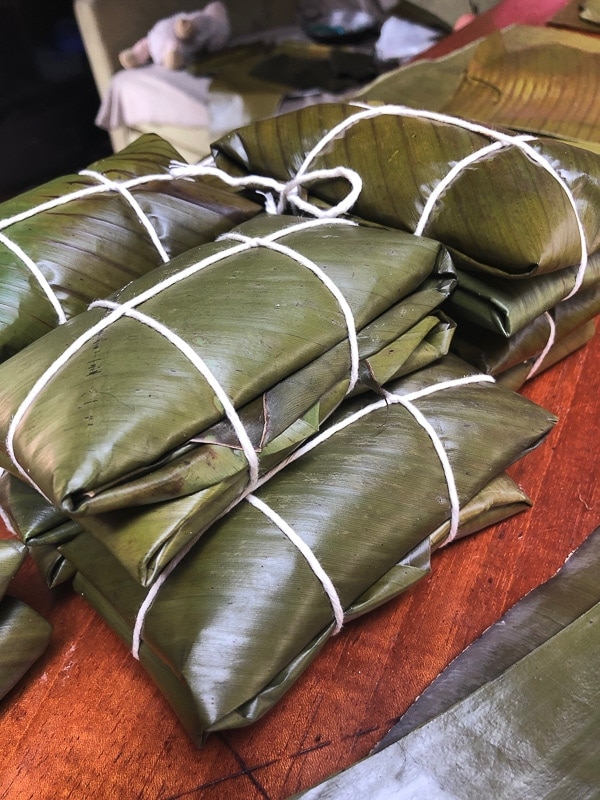
In this post, I’ll tell you exactly how to make traditional Costa Rican tamales- step by step! I’ve even got an easy video for you to follow– even if you are making them for the first time, in cold weather, and all by yourself (like I usually do!)
We spent a day making Costa Rican tamales with our Uncle William in Costa Rica. The girls learned a timeless food tradition, and we made delicious food to sell.
William sells tamales year-round to small business employees in San Ramon, Costa Rica. He’s an expert cook, and he does everything traditionally. Check out our day learning to make tamales, and the step-by-step Costa Rican tamale recipe- modified to make in the United States.
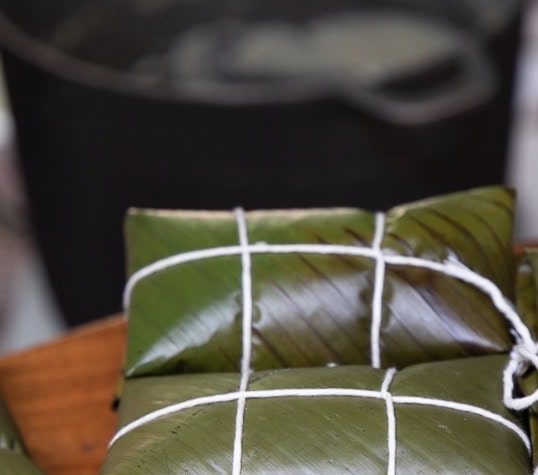
About Costa Rican Tamales
Tamales are an absolute labor of love- and no two people make them in the same way. A tamale is a bit of cooked masa- which is a gluten-free corn-based dough that is steamed in either corn husks or banana leaves. Inside of the masa are fillings that range by country of origin and chef preference, but generally include rice, meat, and vegetables.
Tamales are also called allacas, (Venezuela) nacatamales (Nicaragua) bollos (Colombia) or pasteles (Puerto Rico) depending on the country. The outer wrapping is never eaten but is used as a plate or discarded.
Costa Rican tamales are never made in corn husks, however, that is more of a Mexican tradition that gives the tamales a different flavor.
While in English, we call them tamales, Costa Ricans refer to tamales in the singular- tamal. So we will say that we are eating a Christmas tamal (tamal navideño).
Traditional Costa Rican Tamales Recipe
Ingredients:
Cooking supplies:
Large stockpot (20 qt or larger)
Plantain leaf or banana leaf, cut into 8″ squares
Kitchen twine cut into 14-18″ pieces
Kitchen Scissors
Stirring spoon
For the masa (dough):
Pork broth (can substitute chicken broth)
Maseca tamale mix (cornflour mix found in most grocery stores)
Cold water
1 stick of margarine (can also use pork fat)
1 packet Maggi chicken bullion
Salt (optional)
For the filling:
2-3 pounds cooked pork shoulder (can substitute shredded chicken)
carrots, sliced
red pepper (sweet pepper), chopped
Costa Rican arroz arreglado (do not use dry rice)
Instructions:
The tamales are easiest when you make the rice and pork ahead of time. You can also make the rice while the tamale masa is cooking for the first round, but I prefer just to make the pork and rice the day before.
Start with your very large stockpot. Add your entire packet of Maseca or a similar tamal base to the pot. Next, add 2 cups of cold water and begin to mix this with your hands. The cold water will help so that the Maseca doesn’t form little balls when you add the other ingredients.
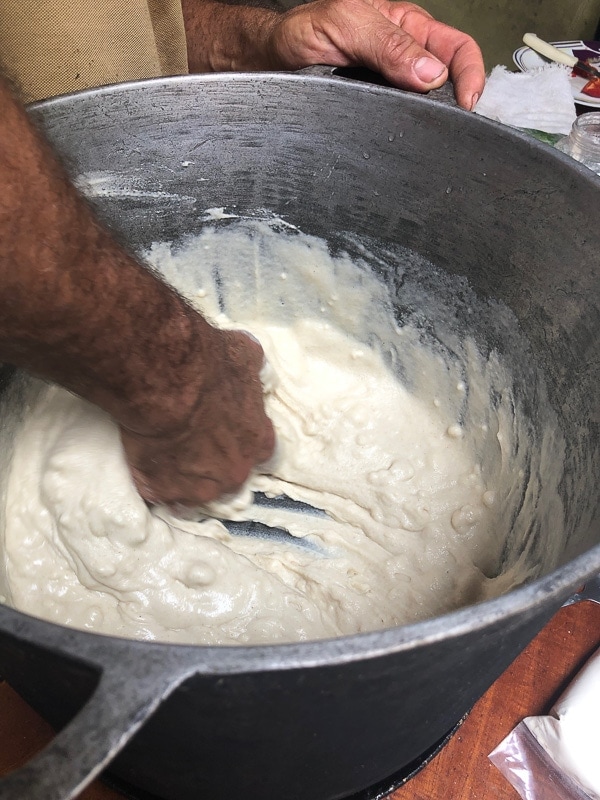
Add 2-4 cups of pork broth, chilled to room temperature, to the masa mixture. Stir until well mixed. (If you don’t have pork broth, chicken, or beef from a box will do).
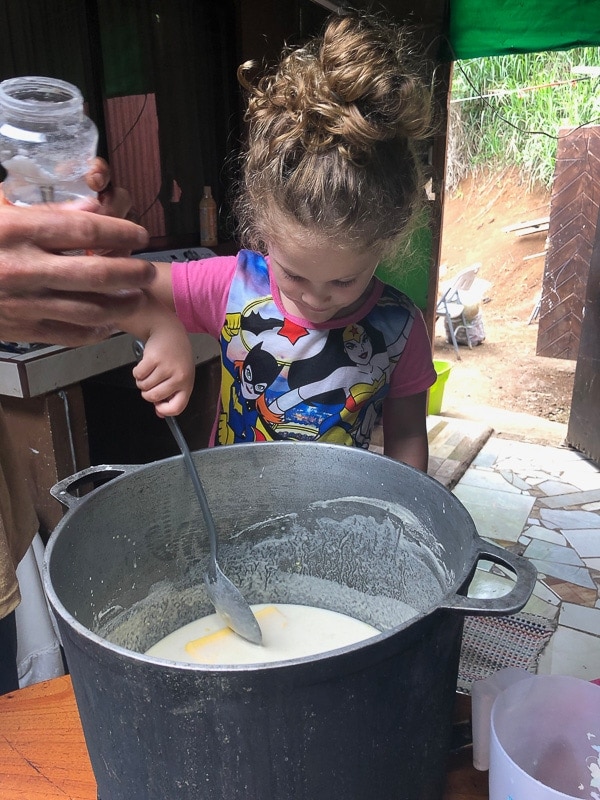
Next add margarine, shortening, or pork fat and your packet of chicken bouillon (consome de pollo). Keep mixing everything until you have a base masa that is the consistency of a watery cream of wheat.
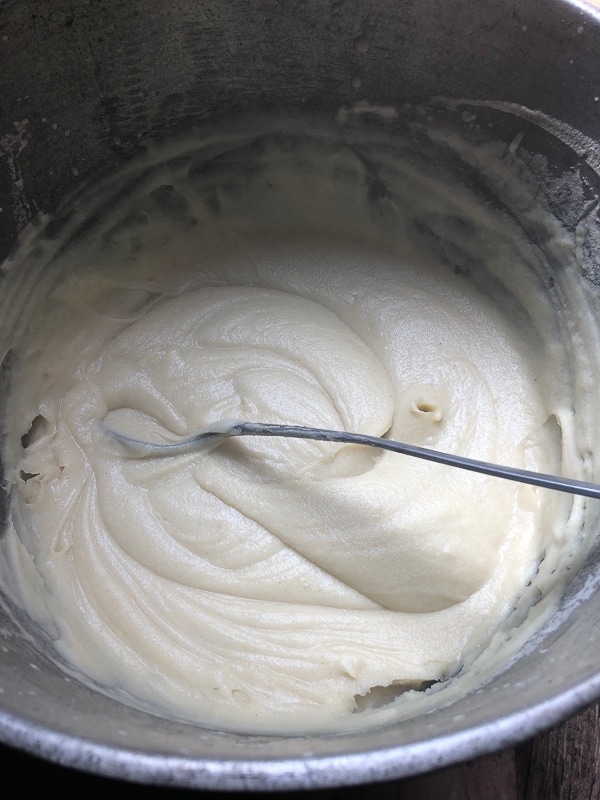
Place ingredients on a hot stove and begin to heat, stirring occasionally to mix all the ingredients. Traditional Costa Rican cooking style calls to complete this step over an open fire or on a wood-burning stove, but I just do it on my regular old stove.
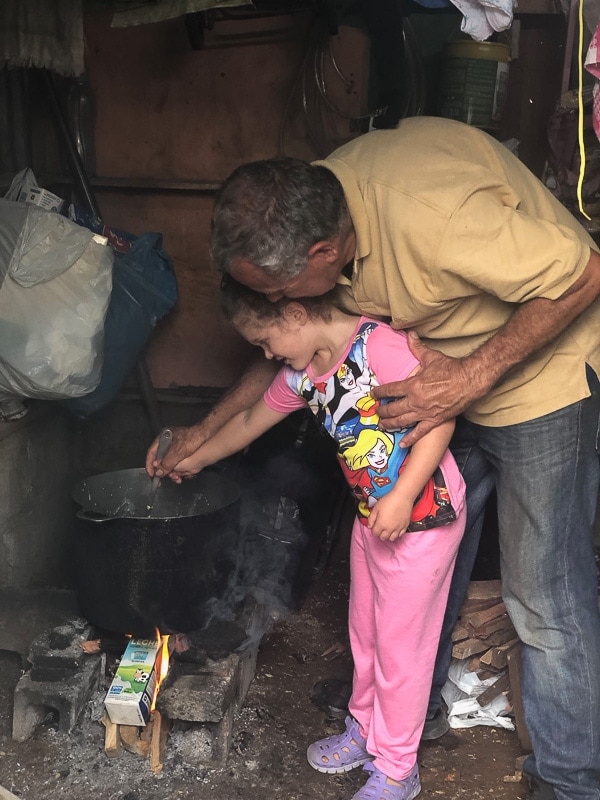
You will heat and stir until the mixture boils and the consistency is that of cream of wheat. If you like your tamales a bit saltier, you can taste this as you go and add up to an additional 2 tablespoons of salt. Some people add a bit of black pepper here but I never do.
While the mixture is cooking, someone usually sets up the plantain leaves and string to begin preparing for the next step: assembling the tamales.
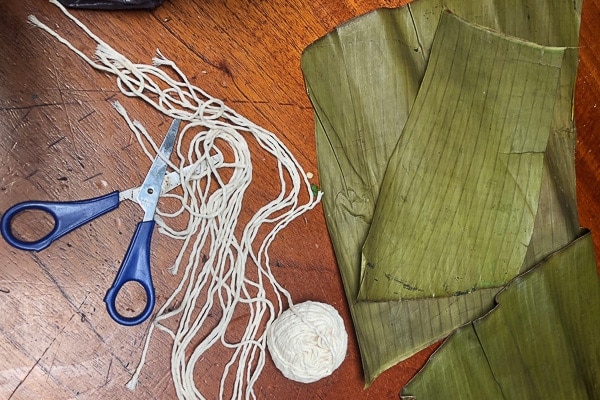
In Costa Rica, plantain leaves are huge and a dime a dozen, but in the States, you may have to buy banana leaves instead. I recommend double-wrapping the tamales either way. This means placing two plantain leaves on top of each other.
Once you have laid out all of the leaves, start by placing a good spoonful of masa in the middle of each leaf. I would say this is just over 1/2 cup of masa.
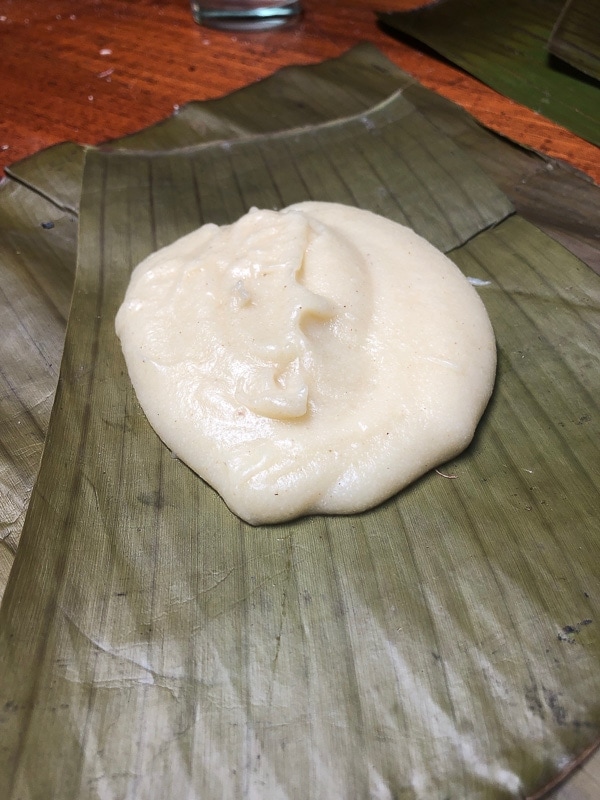
Next place a bit of rice in the middle of the masa. From here add a couple of carrot slices, a few red pepper slices, and some pork. Some people add peas, hard-boiled eggs, raisins, garbanzo beans, mashed potatoes, onion, green sweet pepper, green beans, etc. Our family doesn’t.
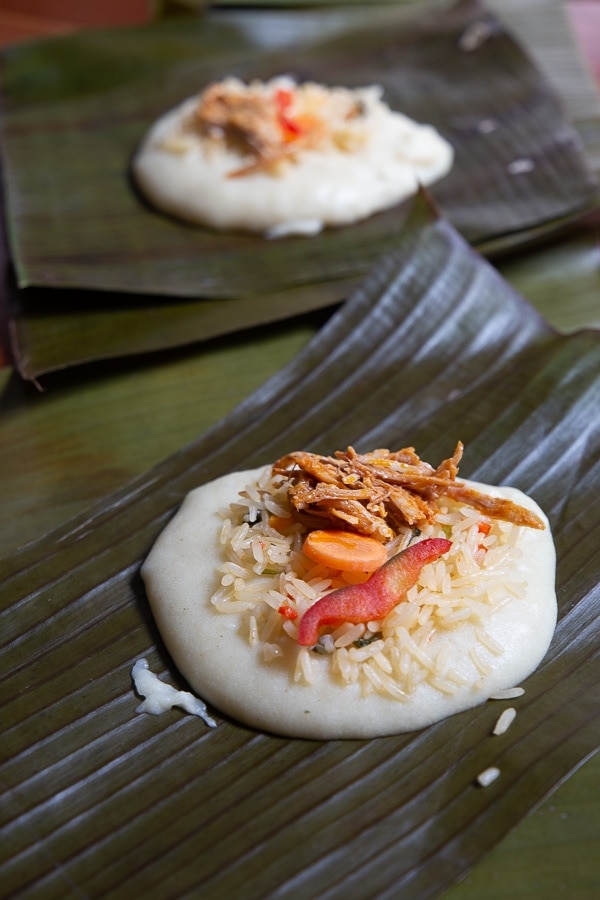
Now you will fold the tamale. Pull up each of the long ends and roll them down as if you were folding a bag of chips or a paper lunch sack. Flatten this down on top of the tamale, then fold the short ends over. Place one tamal on top of the other and wrap them tightly with twine. (see video for instructions)
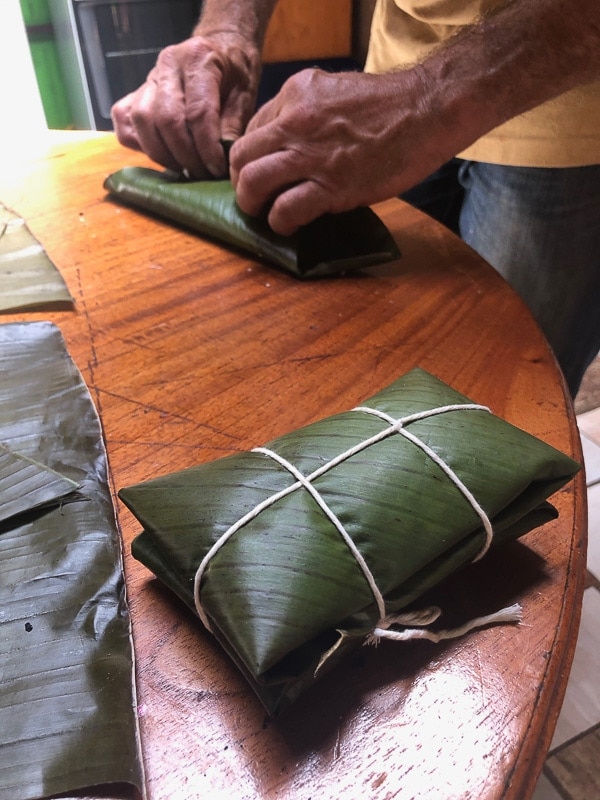
When you wrap these, it’s just like wrapping the ribbon around a Christmas present- except you do it twice- one time on each side.
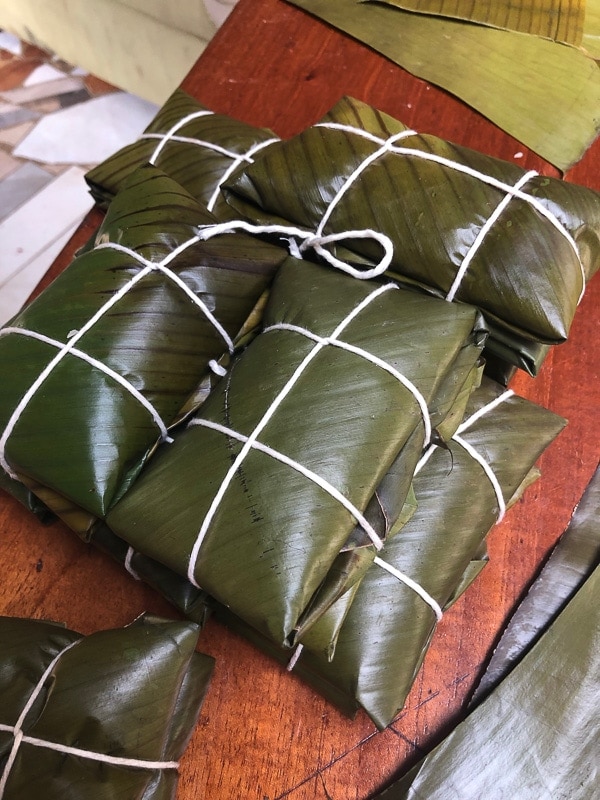
Place all of the tamales back into a large pot (or just wash the one you were just using) and cover them with water. Cover and bring to a rolling boil.
Boil the packets for 30 minutes. turn off the heat and let it cool in the boiling water for at least 30 more minutes. Remove, dry, and enjoy. In true Costa Rican style, you can slather the tamales with Salsa Lizano, and eat with hot coffee and good company.
Other Costa Rican Holiday Food Traditions
Tamales are a Costa Rican Christmas tradition. Here’s a list of other Costa Rican holiday foods:
- Melcochas de natilla homemade candies (December)
- arroz con pollo chicken and rice (Every holiday under the sun)
- Tamal de masa dessert (Easter)
- Empanadas de chiverre (Easter)
- Costa Rican Egg Nog – Rompope (Christmas)
Join me over at my favorite place- Instagram.
Making Tamales- What To Know
One of my favorite Costa Rican tamal traditions is the exchange of tamales at Christmas time. Starting in November, people make loads of tamales and gift them to friends and neighbors. Not only is it a generous tradition, but it is also a great way to show off your tamal-making skills and gain a reputation for the best tamales around. A few tamale rules:
- Rule #1- you don’t ever make tamales alone. They are labor-intensive, and also a cultural tradition. You can join a tamalada, which is a tamal-making party, where everyone brings an ingredient, helps in the preparation of the tamal, and splits the booty.
- Rule #2- Patience. Making tamales is an all-day affair. Plan to have snacks on hand (empanadas anyone?), lots of coffee, and a good soundtrack.
- Rule #3– Christmas tamales have no calories! 🙂 Enjoy them as such, in the true pura vida spirit.
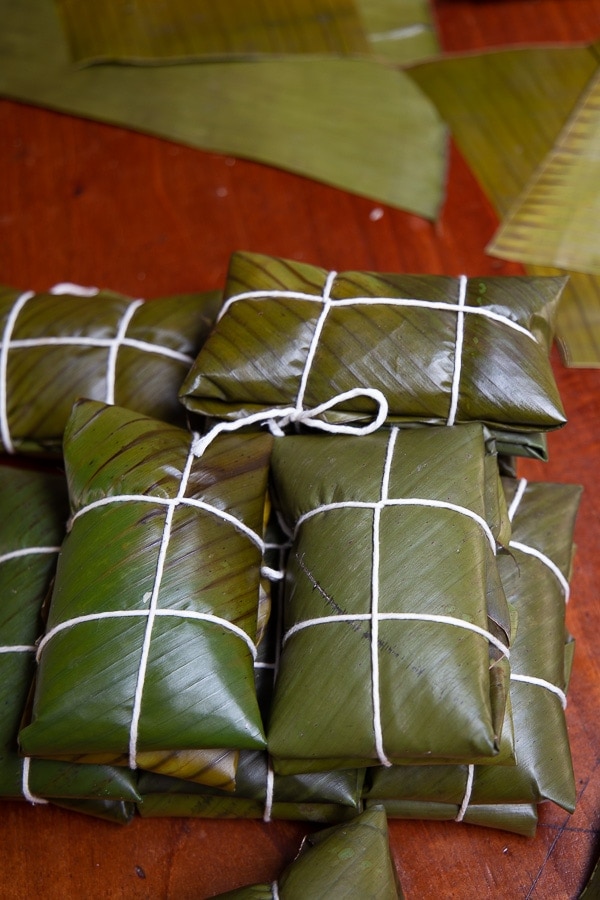
What To Serve With Costa Rican Tamal
Tamales are eaten at almost any time of the day. Many people heat them for breakfast and enjoy them with either agua dulce (sweet water) or coffee.
You might eat them with rice and beans for lunch, or in the evening enjoy them with a nice cold Imperial. Anytime is a good time to enjoy a Christmas tamal!
Many Costa Ricans will put a nice slather of Salsa Lizano on their tamales after heating them.
How To Reheat Tamales
Costa Rican tamales can be eaten at room temperature, but they are so much more delicious warm!
To reheat, you can either zap them in the microwave with their plantain leaves on or just boil them again in hot water (again, keeping the leaves on).
You can also place them in a frying pan and cover them, adding about 1/4 a cup of water and heating on medium until the desired temperature.

Where To Buy Tamales In Costa Rica
If you are visiting Costa Rica, you can get tamales any time of the year. Don’t be fooled though, you’ll never see them on a menu.
Many bakeries sell them, or you can just ask local restaurants if they have any or know where to buy them.
Be prepared, as Costa Ricans don’t expect tourists to want to eat tamales, and they may be reluctant to tell you where to get them!
Also, don’t be surprised if someone just brings tamales out of the back of the restaurant or shop and gifts them to you- refusing to let you pay. In that case, a heavy dose of muchas gracias is in order.
Finally, many street food vendors sell them as well. Expect to pay between $1-$3 (500-1,500 colones) for a piña de tamal.
In the States, if you know a Costa Rican then you might ask if they are making tamales and would give or sell you some.
Otherwise, we live in an area with a lot of Salvadoreans, and their tamales are generally very similar to Costa Rican tamales. At least enough so that we purchase them and slather tons of Lizano on them and they taste like home.
Like Pura Vida Moms on Facebook and never miss a post!
Printable Costa Rican Tamales Recipe
Costa Rican Pork Tamales Recipe

These Costa Rican tamales are made in the traditional style with rice, vegetables and pork. Costa Rican Christmas tradition.
Ingredients
- Cooking supplies:
- Large stockpot (20 qt or larger)
- Plantain leaf or banana leaf, cut into 8" squares
- String or twine cut into 14-18" pieces
- Scissors
- Stirring spoon
- For the masa (dough):
- Pork broth (can substitute chicken broth)
- Maseca tamale mix (cornflour mix found in most grocery stores)
- Cold water
- 1 stick of margarine (can also use pork fat)
- 1 packet Maggi chicken bullion (consome de pollo)
- Salt (optional)
- For the filling:
- 2-3 pounds cooked pork shoulder (can substitute shredded chicken)
- carrots
- red pepper (sweet pepper)
- Costa Rican arroz arreglado (do not use dry rice) Recipe link above
Instructions
- The tamales are easiest when you make ahead the rice and pork. You can also make the rice while the tamale masa is cooking for the first round, but I prefer just to make the pork and rice the day before.
- Start with your very large stockpot. Add your entire packet of Maseca or similar tamal base to the pot. Next, add 2 cups of cold water and begin to mix this with your hands. The cold water will help so that the Maseca doesn't form little balls when you add the other ingredients.
- Add 2-4 cups of pork broth, chilled to room temperature, to the masa mixture. Stir until well mixed. (If you don't have pork broth, chicken or beef from a box will do).
- Next add margarine, shortening, or pork fat and your packet of chicken bouillon (consome de pollo). Keep mixing everything until you have a base masa that is the consistency of watery cream of wheat.
- Place ingredients on a hot stove and begin to heat, stirring occasionally to mix all the ingredients. Traditional Costa Rican cooking style calls to complete this step over an open fire or on a wood-burning stove, but I just do it on my regular old stove.
- You will heat and stir until the mixture boils and the consistency is that of cream of wheat. If you like your tamales a bit saltier, you can taste this as you go and add up to an additional 2 tablespoons of salt. Some people add a bit of black pepper here but I never do.
- While the mixture is cooking, someone usually sets up the plantain leaves and string to begin preparing for the next step: assembling the tamales.
 In Costa Rica, plantain leaves are huge and a dime a dozen, but in the States, you may have to buy banana leaves instead. I recommend double wrapping the tamales either way. This means placing two plantain leaves on top of each other.
In Costa Rica, plantain leaves are huge and a dime a dozen, but in the States, you may have to buy banana leaves instead. I recommend double wrapping the tamales either way. This means placing two plantain leaves on top of each other. - Once you have laid out all of the leaves, start by placing a good spoonful of masa in the middle of each leaf. I would say this is just over 1/2 cup of masa.
- Next place a bit of rice in the middle of the masa. From here add a couple of carrot slices, a few red pepper slices, and some pork. Some people add peas, hard-boiled egg, raisins, garbanzo beans, mashed potatoes, onion, green sweet pepper, green beans, etc. Our family doesn't.
- Now you will fold the tamale. Pull up each of the long ends and roll them down as if you were folding a bag of chips or a paper lunch sack. Flatten this down on top of the tamale, then fold the short ends over. Place one tamal on top of the other and wrap them tightly with twine.
- When you wrap these, it's just like wrapping the ribbon around a Christmas present- except you do it twice- one time on each side.
- Place all of the tamales back into a large pot (or just wash the one you were just using) and cover them with water. Cover and bring to a rolling boil.
- Boil the packets for 30 minutes. turn ff the heat and let cool in the boiling water for at least 30 more minutes. Remove, dry, and enjoy. In true Costa Rican style, you can slather with Salsa Lizano, and eat with coffee and good company.
Notes
You can halve this recipe if you want. Just depends on how many tamales you want to make!
You can pretty much buy all of these ingredients at any Walmart year-round, but especially at Christmas. I'm including Amazon links here in case you can't get to a Walmart, or so you have a visual for what you are looking for. Of course, you can order from Amazon, but it won't be the best deal!
Recommended Products
As an Amazon Associate and member of other affiliate programs, I earn from qualifying purchases.
Don’t forget to Pin it!
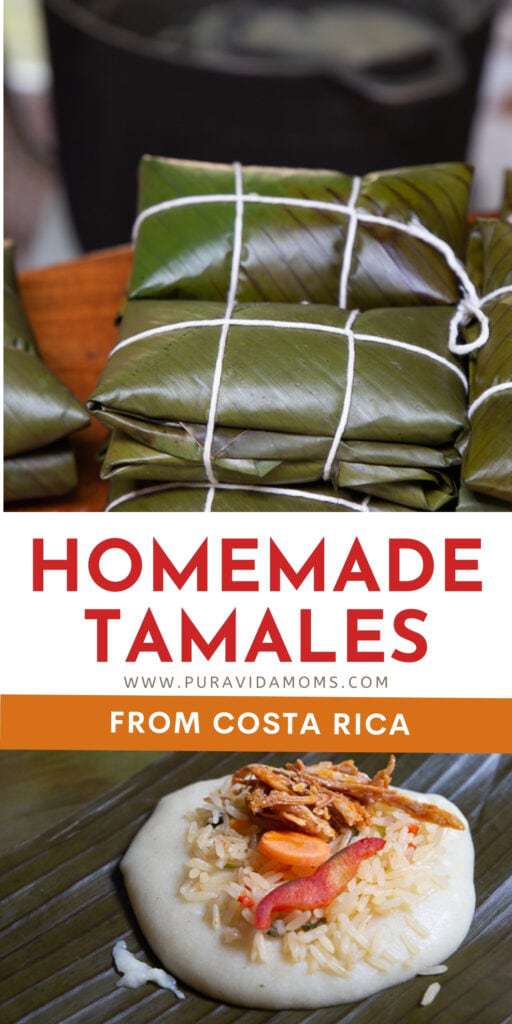

Christa Jimenez
Welcome! I’m Christa, a Spanish teacher married to a handsome Costa Rican and mother of two bilingual daughters. We’ve spent over 25 years living in and traveling to Costa Rica with our daughters, and this website is my love letter to all things Costa Rica- and to bilingual parenting too. You can read my full story here. Thanks for stopping by!

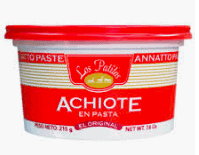
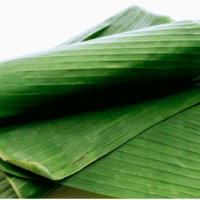
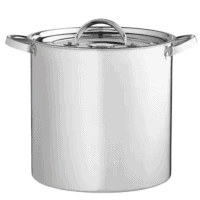
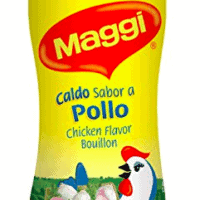
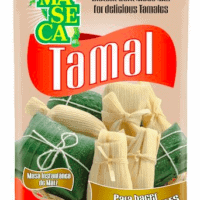
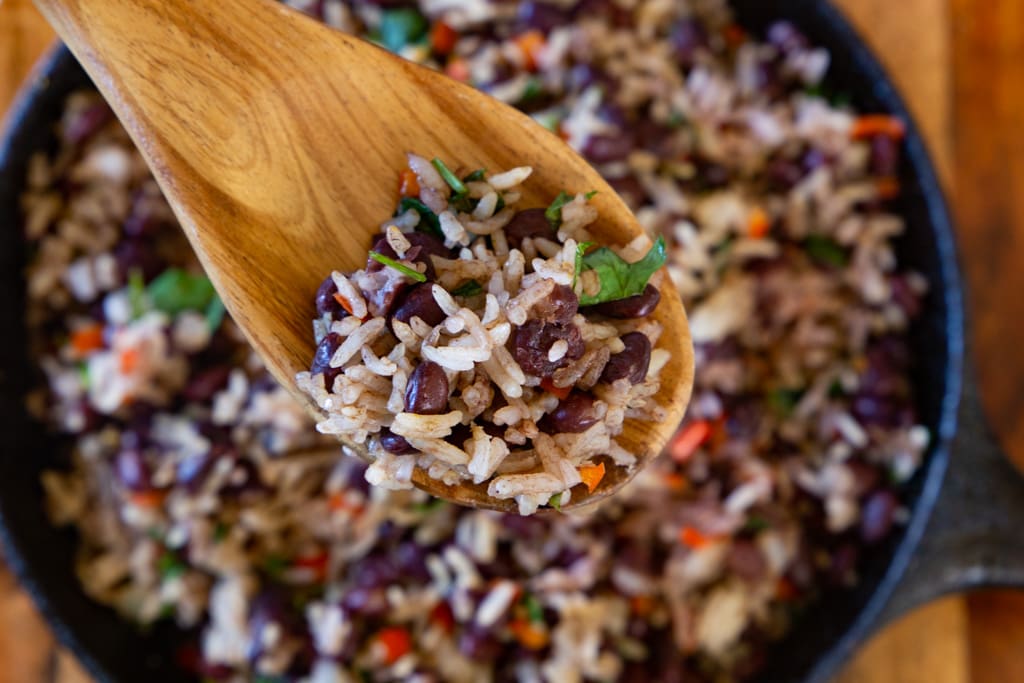
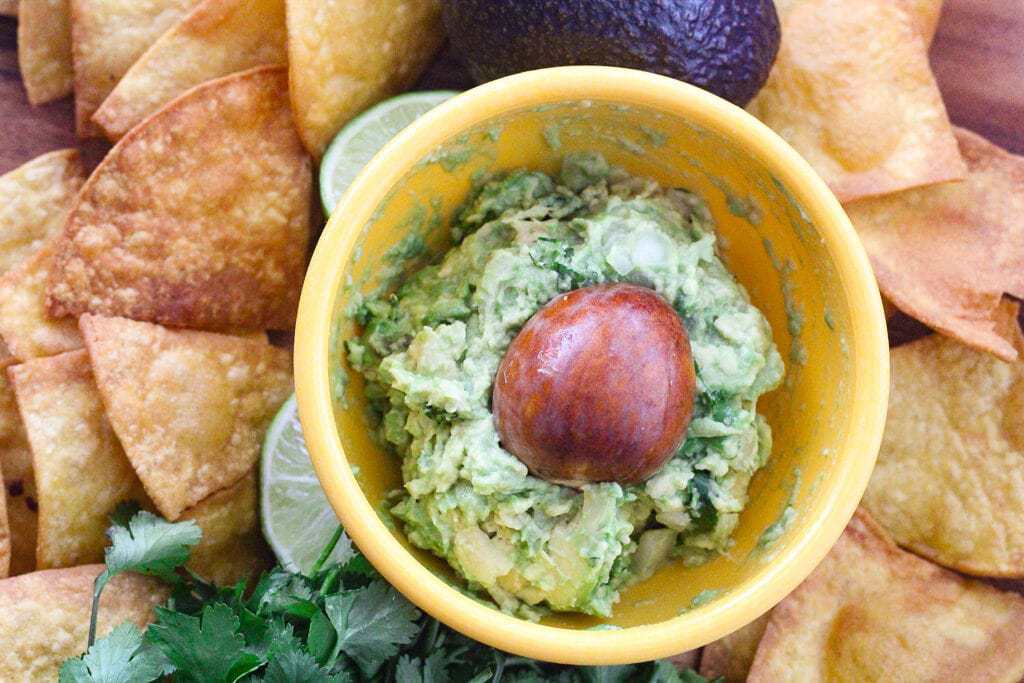
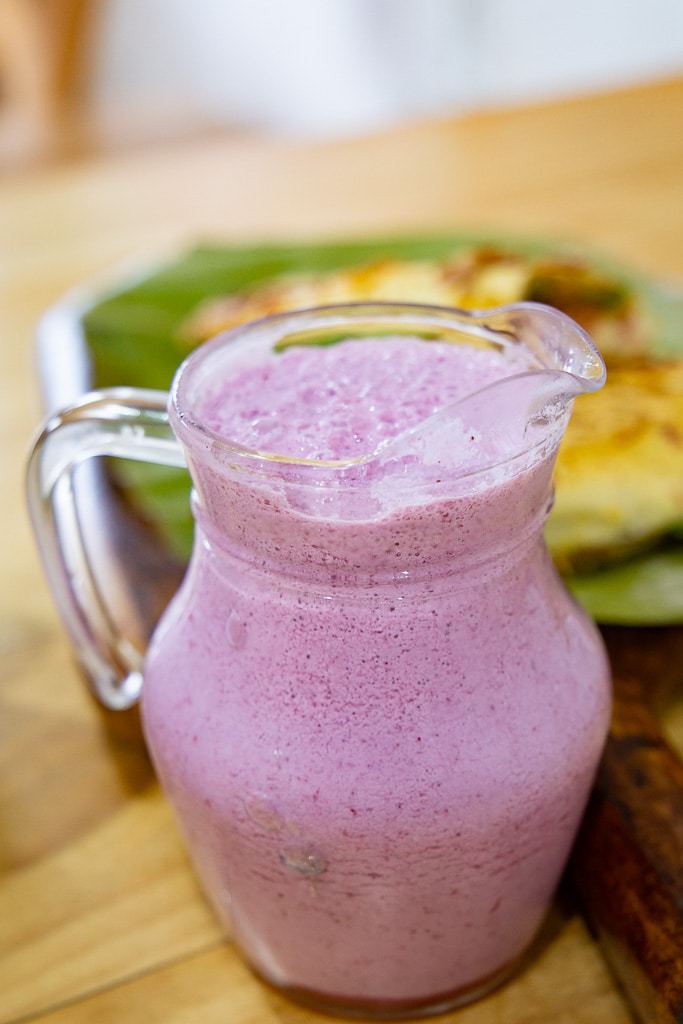
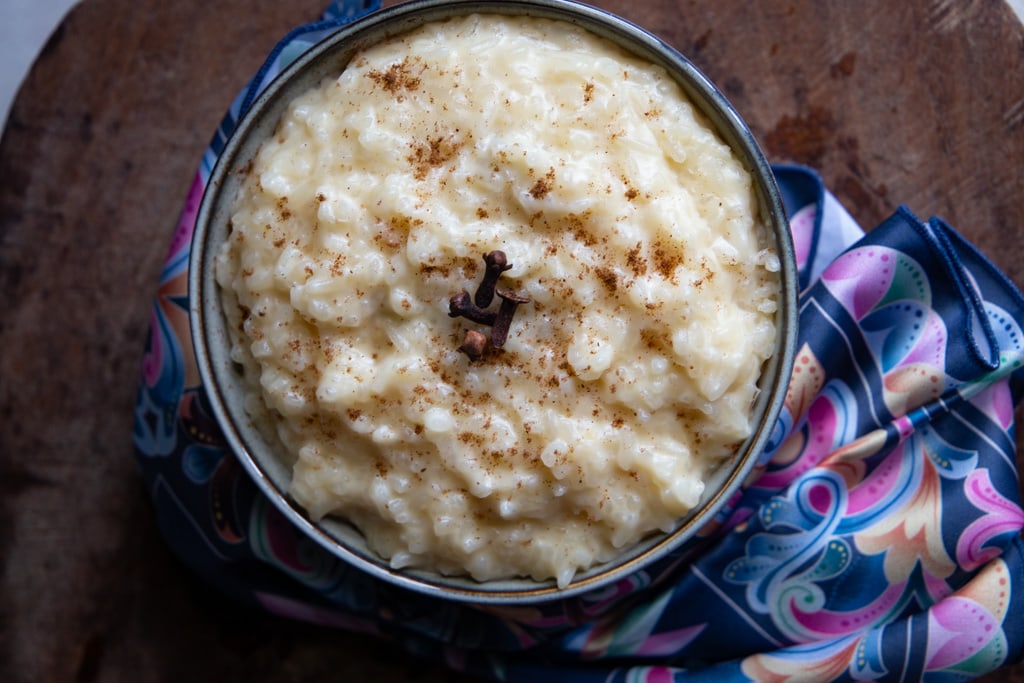
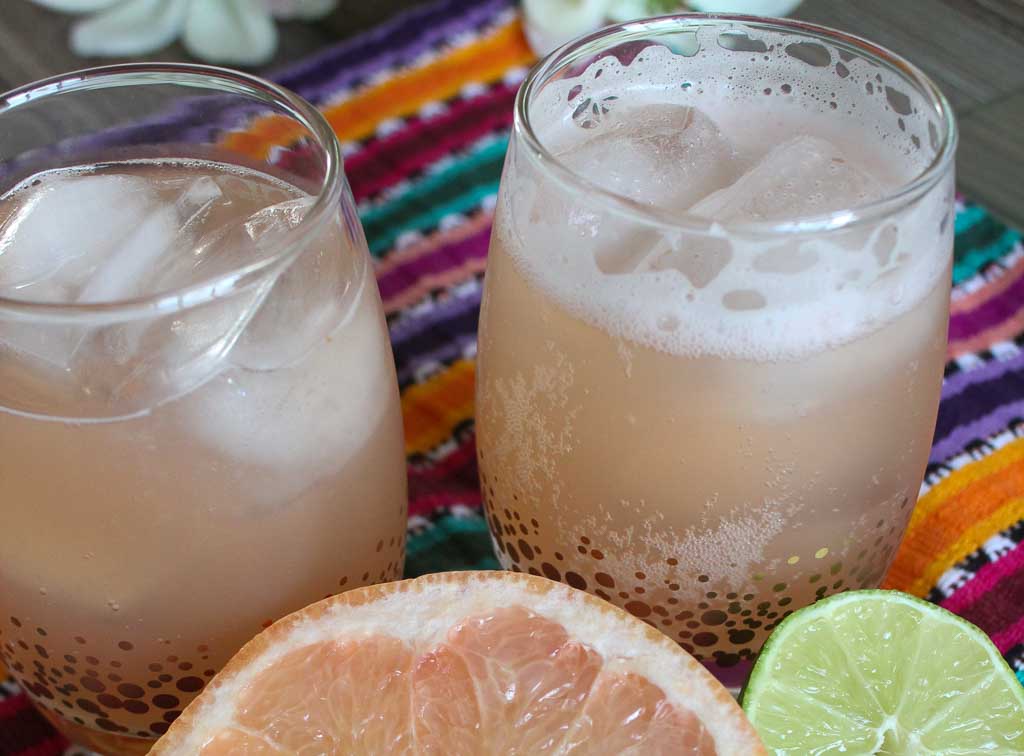
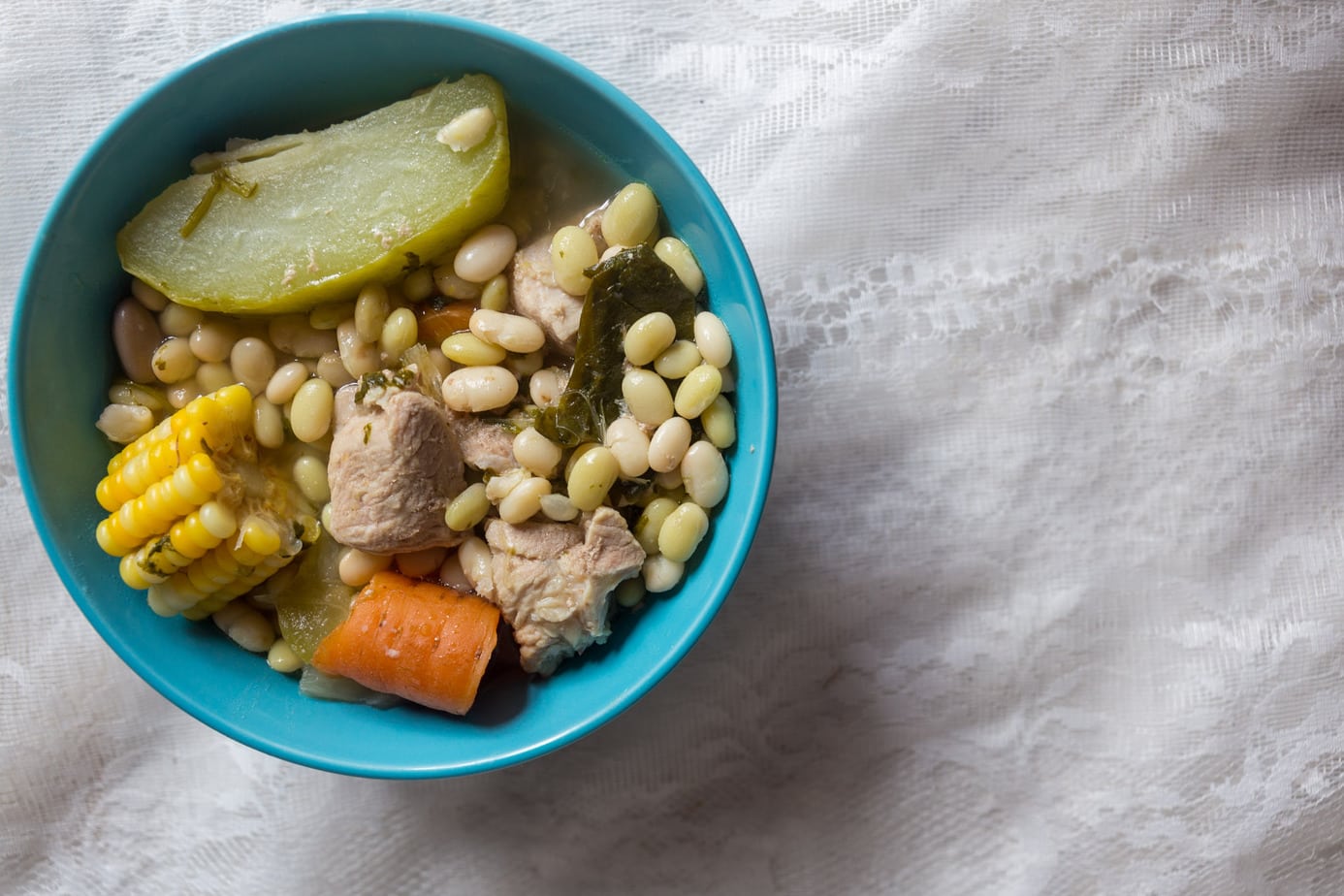

Do you have a recipe for FRESH masa? I have 5lbs of Fresh Masa to use.
If you already have the masa- that’s awesome. Just start by ladling the masa out and then follow the rest of the recipe from there. Where did you get the fresh masa? Thanks for commenting! Pura Vida ~Christa
Que rico my mouth is full of water(saliva) you put everything together like a “tica” and the pictures look perfect.This year I will eat tamales in Costa Rica I make them here in the States but the bananas leaves doesn’t have the costarrican taste!!! because they put them in the fogon the leaves taste better Congratulation for you site Y que viva Costa Rica libre y soverana .Gina
the recipe is wonderful one question I have ,how to prepare the leaves we buy at the supermarket
I just wash them and let them dry!
If you are lucky enough to get fresh plaintain leaves ,they must be prepared to fold them without cracking or breaking . the best way to do this is don’t cut them off the banana or plaintain tree more than just a few days before making , then the traditional way to soften them is with a outdoor simple wood stove made with 2 cinderblocks spaced about a foot (or more) apart and a bbq grill on top , make a medium to large fire inbetween the blocks and quickly pull the whole leaf over the flames on the grill ,sometimes this takes a few times , you will clearly see the color change as they heat up and the oil or water that is in the leaves is quickly cooked out. (and they shrink a little bit too ) just a quick pass over the flame on each side , don’t let them blister or dry out too much , then on a flat surface with a damp cloth wipe of any soot or dirt . then when it is time to cook the tamales do this over the same cinderblock woodfire bbq this imparts a wonderful authentic smokey flavor to the cooking water . and many cooks make thick masa and thin it with lizano ,
Such good notes- thank you!
Do you have measurements for the masa dough? It says one package of tamal mix and one packet of maggi. I just want to make sure I get it right!
Hi! Sorry for the delay. I think the packet of masa is 4.4 lbs and the maggie is 2 ounces.
Thanks, but you forgot the video!
I see it just above the heading that says “How to reheat the tamales.” Do you not see it? Pura vida! ~Christa
If I am making a whole bunch and need to freeze some, would you recommend freezing before cooking?
I would definitely freeze after cooking. Then you can just defrost and reheat. Pura Vida! ~Christa
About how many tamales does this recipe make? How many banana/plantain leaves should I buy? In the recipe it says one. I am excited to try this, thank you for putting it together!
Katie
Ahh! I’d say about two dozen. Let me know how it turns out!
Two dozen tamales or two dozen piñas?
Great question! Pina!
have you tried cooking them in the Instant Pot vs the large pot?
I haven’t- yet. I always make the whole batch and then get nervous to try a new cooking method because they are so much work in the first place! 😂 Pura vida!
Thanks for this post. I’ve been making these for a Costa Rican in-law who is in the US, and he says every year I’m getting closer to how his family makes them. I know every family does them different, so this gives me a good idea where to start.
Yay! Let me know how they come out!